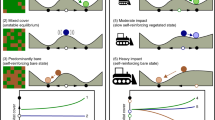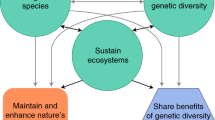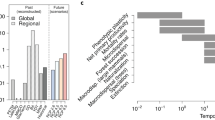Abstract
Global conservation targets to reverse biodiversity declines and halt species extinctions are not being met despite decades of conservation action. However, a lack of measurable change in biodiversity indicators towards these targets is not necessarily a sign that conservation has failed; instead, temporal lags in species’ responses to conservation action could be masking our ability to observe progress towards conservation success. Here we present our perspective on the influence of ecological time lags on the assessment of conservation success and review the principles of time lags and their ecological drivers. We illustrate how a number of conceptual species may respond to change in a theoretical landscape and evaluate how these responses might influence our interpretation of conservation success. We then investigate a time lag in a real biodiversity indicator using empirical data and explore alternative approaches to understand the mechanisms that drive time lags. Our proposal for setting and evaluating conservation targets is to use milestones, or interim targets linked to specific ecological mechanisms at key points in time, to assess whether conservation actions are likely to be working. Accounting for ecological time lags in biodiversity targets and indicators will greatly improve the way that we evaluate conservation successes.
This is a preview of subscription content, access via your institution
Access options
Access Nature and 54 other Nature Portfolio journals
Get Nature+, our best-value online-access subscription
$29.99 / 30 days
cancel any time
Subscribe to this journal
Receive 12 digital issues and online access to articles
$119.00 per year
only $9.92 per issue
Buy this article
- Purchase on Springer Link
- Instant access to full article PDF
Prices may be subject to local taxes which are calculated during checkout





Similar content being viewed by others
References
Tittensor, D. P. et al. A mid-term analysis of progress toward international biodiversity targets. Science 346, 241–244 (2014).
Global Biodiversity Outlook 4 (Secretariat of the Convention on Biological Diversity, 2014).
Mace, G. M. et al. Aiming higher to bend the curve of biodiversity loss. Nat. Sustain. 1, 448–451 (2018).
Jackson, S. T. & Sax, D. F. Balancing biodiversity in a changing environment: extinction debt, immigration credit and species turnover. Trends Ecol. Evol. 25, 153–160 (2010).
Kuussaari, M. et al. Extinction debt: a challenge for biodiversity conservation. Trends Ecol. Evol. 24, 564–571 (2009).
Hylander, K. & Ehrlén, J. The mechanisms causing extinction debts. Trends Ecol. Evol. 28, 341–346 (2013).
Figueiredo, L., Krauss, J., Steffan-Dewenter, I. & Sarmento Cabral, J. Understanding extinction debts: spatio–temporal scales, mechanisms and a roadmap for future research. Ecography 42, 1973–1990 (2019).
Tilman, D., May, R. M., Lehman, C. L. & Nowak, M. A. Habitat destruction and the extinction debt. Nature 371, 65–66 (1994).
Krauss, J. et al. Habitat fragmentation causes immediate and time-delayed biodiversity loss at different trophic levels. Ecol. Lett. 13, 597–605 (2010).
Lira, P. K., de Souza Leite, M. & Metzger, J. P. Temporal lag in ecological responses to landscape change: where are we now? Curr. Landsc. Ecol. Rep. 4, 70–82 (2019).
Cristofoli, S. & Mahy, G. Colonisation credit in recent wet heathland butterfly communities. Insect Conserv. Divers. 3, 83–91 (2010).
Kolk, J., Naaf, T. & Wulf, M. Paying the colonization credit: converging plant species richness in ancient and post-agricultural forests in NE Germany over five decades. Biodivers. Conserv. 26, 735–755 (2017).
Hanski, I. Extinction debt and species credit in boreal forests: modelling the consequences of different approaches to biodiversity conservation. Ann. Zool. Fennici 37, 271–280 (2000).
Naaf, T. & Kolk, J. Colonization credit of post-agricultural forest patches in NE Germany remains 130–230 years after reforestation. Biol. Conserv. 182, 155–163 (2015).
Essl, F. et al. Delayed biodiversity change: no time to waste. Trends Ecol. Evol. 30, 375–378 (2015).
Metzger, J. P. et al. Time-lag in biological responses to landscape changes in a highly dynamic Atlantic forest region. Biol. Conserv. 142, 1166–1177 (2009).
Preparations for the Post-2020 Biodiversity Framework (CBD, 2019); https://www.cbd.int/conferences/post2020
Brown, C., Alexander, P., Arneth, A., Holman, I. & Rounsevell, M. Achievement of Paris climate goals unlikely due to time lags in the land system. Nat. Clim. Change 9, 203–208 (2019).
MacArthur, R. H. & Wilson, E. O. The Theory of Island Biogeography (Princeton Univ. Press, 1967).
Hanski, I. Metapopulation dynamics. Nature 396, 41–49 (1998).
Koyanagi, T. et al. Grassland plant functional groups exhibit distinct time-lags in response to historical landscape change. Plant Ecol. 213, 327–338 (2012).
Whytock, R. C. et al. Bird-community responses to habitat creation in a long-term, large-scale natural experiment. Conserv. Biol. 32, 345–354 (2018).
Vellend, M. et al. Extiction debt of forest plants persists for more than a century following habitat fargmentation. Ecology 87, 542–548 (2006).
Cousins, S. A. O. & Vanhoenacker, D. Detection of extinction debt depends on scale and specialisation. Biol. Conserv. 144, 782–787 (2011).
Hanski, I. & Ovaskainen, O. Extinction debt at extinction threshold. Conserv. Biol. 16, 666–673 (2002).
Pereira, H. M. et al. Essential biodiversity variables. Science 339, 277–278 (2013).
Wild Bird Populations in England, 1970 to 2017 (Defra, 2018).
Loh, J. et al. The Living Planet Index: Using species population time series to track trends in biodiversity. Philos. Trans. R. Soc. B 360, 289–295 (2005).
UK Biodiversity Indicators 2019 (Defra, 2019).
Fuller, R. J., Noble, D. G., Smith, K. W. & Vanhinsbergh, D. Recent declines in populations of woodland birds in Britain: a review of possible causes. Brit. Birds 98, 116–143 (2005).
Bowler, D. E., Heldbjerg, H., Fox, A. D., Jong, M. & Böhning‐Gaese, K. Long‐term declines of European insectivorous bird populations and potential causes. Conserv. Biol. 33, 1120–1130 (2019).
Vickery, J. A. et al. The decline of Afro-Palaearctic migrants and an assessment of potential causes. Ibis 156, 1–22 (2014).
Savory, C. J. Colonisation by woodland birds at Carrifran Wildwood: the story so far. Scot. Birds 36, 135–149 (2016).
Forestry Statistics 2018 (Forestry Commission, 2018).
Quine, C. P., Bailey, S. A. & Watts, K. PRACTITIONER’S PERSPECTIVE: Sustainable forest management in a time of ecosystem services frameworks: Common ground and consequences. J. Appl. Ecol. 50, 863–867 (2013).
Watts, K. et al. Using historical woodland creation to construct a long-term, large-scale natural experiment: the WrEN project. Ecol. Evol. 6, 3012–3025 (2016).
Lira, P. K., Ewers, R. M., Banks-Leite, C., Pardini, R. & Metzger, J. P. Evaluating the legacy of landscape history: extinction debt and species credit in bird and small mammal assemblages in the Brazilian Atlantic Forest. J. Appl. Ecol. 49, 1325–1333 (2012).
Bulman, C. R. et al. Minimum viable metapopulation size, extinction debt, and the conservation of a declining species. Ecol. Appl. 17, 1460–1473 (2007).
Synes, N. W. et al. A multi-species modelling approach to examine the impact of alternative climate change adaptation strategies on range shifting ability in a fragmented landscape. Ecol. Inform. 30, 222–229 (2015).
Orrock, J. L. & Watling, J. I. Local community size mediates ecological drift and competition in metacommunities. Proc. R. Soc. B 277, 2185–2191 (2010).
Halley, J. M. & Iwasa, Y. Neutral theory as a predictor of avifaunal extinctions after habitat loss. Proc. Natl Acad. Sci. USA 108, 2316–2321 (2011).
Bocedi, G. et al. RangeShifter: a platform for modelling spatial eco-evolutionary dynamics and species’ responses to environmental changes. Methods Ecol. Evol. 5, 388–396 (2014).
Synes, N. W. et al. Emerging opportunities for landscape ecological modelling. Curr. Landsc. Ecol. Rep. 1, 146–167 (2016).
Shriver, R. K. et al. Transient population dynamics impede restoration and may promote ecosystem transformation after disturbance. Ecol. Lett. 22, 1357–1366 (2019).
Key Elements of the Strategic Plan 2011-2020: II. VISION (CBD, 2019); https://www.cbd.int/sp/elements/#II
Hoffmann, M. et al. The difference conservation makes to extinction risk of the world’s ungulates. Conserv. Biol. 29, 1303–1313 (2015).
R Core Team R: A Language and Environment for Statistical Computing (R Foundation for Statistical Computing, 2019).
Venables, W. N. & Ripley, B. D. Modern Applied Statistics with S 4th edn (Springer, 2002).
Bartoń, K. A. MuMIn: Multi-Model Inference R package version 1.42.1 (May 2019); https://cran.r-project.org/package=MuMIn
Acknowledgements
We thank all land owners who granted us permission to conduct surveys on their land, R. Whytock, P. French and P. Barbose De Andrade for assistance with data collection. This work has been developed with funding and logistical support from the Forestry Commission, University of Stirling, Natural England, Department for Environment, Food and Rural Affairs, The National Forest Company, Scottish Natural Heritage, Tarmac and the Woodland Trust. R.C.W. was funded by the Natural Research Environment Council IAPETUS Doctoral Training Partnership (grant no. NE/L002590/1) with CASE funding from Forest Research.
Author information
Authors and Affiliations
Contributions
K.W., K.J.P., E.F.-M. and N.A.M. conceived and designed the WrEN Project. K.W., R.C.W., N.A.M. and P.J.K.M. designed the time-lags study. K.W., R.C.W. and S.D. collated and supplied the indicator data. R.C.W. collected and analysed the bird data. K.W. and R.C.W. wrote the manuscript. All authors discussed the results and contributed to the manuscript.
Corresponding author
Ethics declarations
Competing interests
The authors declare no competing interests.
Additional information
Publisher’s note Springer Nature remains neutral with regard to jurisdictional claims in published maps and institutional affiliations.
Rights and permissions
About this article
Cite this article
Watts, K., Whytock, R.C., Park, K.J. et al. Ecological time lags and the journey towards conservation success. Nat Ecol Evol 4, 304–311 (2020). https://doi.org/10.1038/s41559-019-1087-8
Received:
Accepted:
Published:
Issue Date:
DOI: https://doi.org/10.1038/s41559-019-1087-8
This article is cited by
-
Fruit parasitism and abundance of a non-native insect pest affects abundances of some songbirds
Biological Invasions (2023)
-
Widespread extinction debts and colonization credits in United States breeding bird communities
Nature Ecology & Evolution (2022)
-
Towards a multidimensional biodiversity index for national application
Nature Sustainability (2021)
-
Disparity between ecological and political timeframes for species conservation targets
Biodiversity and Conservation (2021)
-
Can epiphytic lichens of remnant Atlantic oakwood trees in a planted ancient woodland site survive early stages of woodland restoration?
Annals of Forest Science (2021)



